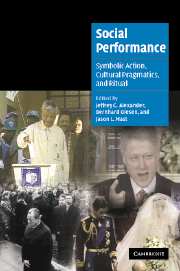Book contents
- Frontmatter
- Contents
- List of figures
- List of tables
- List of contributors
- Introduction: symbolic action in theory and practice: the cultural pragmatics of symbolic action
- 1 Cultural pragmatics: social performance between ritual and strategy
- 2 From the depths of despair: performance, counterperformance, and “September 11”
- 3 The cultural pragmatics of event-ness: the Clinton / Lewinsky affair
- 4 Social dramas, shipwrecks, and cockfights: conflict and complicity in social performance
- 5 Performing a “new” nation: the role of the TRC in South Africa
- 6 Performing opposition or, how social movements move
- 7 Politics as theatre: an alternative view of the rationalities of power
- 8 Symbols in action: Willy Brandt's kneefall at the Warsaw Memorial
- 9 The promise of performance and the problem of order
- 10 Performance art
- 11 Performing the sacred: a Durkheimian perspective on the performative turn in the social sciences
- Index
- Cambridge Cultural Social Studies
- References
Introduction: symbolic action in theory and practice: the cultural pragmatics of symbolic action
Published online by Cambridge University Press: 07 December 2009
- Frontmatter
- Contents
- List of figures
- List of tables
- List of contributors
- Introduction: symbolic action in theory and practice: the cultural pragmatics of symbolic action
- 1 Cultural pragmatics: social performance between ritual and strategy
- 2 From the depths of despair: performance, counterperformance, and “September 11”
- 3 The cultural pragmatics of event-ness: the Clinton / Lewinsky affair
- 4 Social dramas, shipwrecks, and cockfights: conflict and complicity in social performance
- 5 Performing a “new” nation: the role of the TRC in South Africa
- 6 Performing opposition or, how social movements move
- 7 Politics as theatre: an alternative view of the rationalities of power
- 8 Symbols in action: Willy Brandt's kneefall at the Warsaw Memorial
- 9 The promise of performance and the problem of order
- 10 Performance art
- 11 Performing the sacred: a Durkheimian perspective on the performative turn in the social sciences
- Index
- Cambridge Cultural Social Studies
- References
Summary
The question of theory and practice permeates not only politics but culture, where the analogue for theory is the social-symbolic text, the bundle of everyday codes, narratives, and rhetorical configurings that are the objects of hermeneutic reconstruction. Emphasizing action over its theory, praxis theorists have blinded themselves to the deeply embedded textuality of every social action (Bourdieu 1984; Swidler 1986; Turner 2002). But a no less distorting myopia has affected the vision from the other side. The pure hermeneut (e.g., Dilthey 1976; Ricoeur 1976) tends to ignore the material problem of instantiating ideals in the real world. The truth, as Marx (1972: 145) wrote in his tenth thesis on Feuerbach, is that, while theory and practice are different, they are always necessarily intertwined.
Theory and practice are interwoven in everyday life, not only in social theory and social science. In the following chapters, we will see that powerful social actors understand the conceptual issues presented in this introduction in an intuitive, ethnographic, and practical way. In the intense and fateful efforts to impeach and to defend President Clinton (Mast, ch. 3), for instance, individuals, organizations, and parties moved “instinctively” to hook their actions into the background culture in a lively and compelling manner, working to create an impression of sincerity and authenticity rather than one of calculation and artificiality, to achieve verisimilitude. Social movements' public demonstrations (Eyerman, ch. 6) display a similar performative logic.
- Type
- Chapter
- Information
- Social PerformanceSymbolic Action, Cultural Pragmatics, and Ritual, pp. 1 - 28Publisher: Cambridge University PressPrint publication year: 2006
References
- 36
- Cited by



